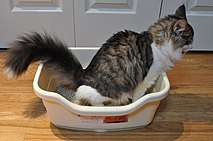Housebreaking
Housebreaking (American English) or house-training (British English) is the process of training a domesticated animal that lives with its human owners in a house or other residence to excrete (urinate and defecate) outdoors, or in a designated indoor area (such as an absorbent pad or a litter box), rather than randomly inside the house following its instinctive behaviour.

The process of housebreaking or house-training requires patience and consistence from the human. Accidents are a part of the process and reacting negatively could discourage the animal, and slow down the training as a whole.
Dogs
The first step in housebreaking or house-training a new puppy is creating a routine or schedule. Young puppies aren't able to control their bladder as well as older dogs and should be taken out frequently. A general rule of thumb to follow is that puppies can hold their bladder one hour for every month; if a puppy is two months they can hold their urine for around two hours.[1] When taking the puppy outside their owner should take them to a designated spot every time. Using a word as they excrete, such as "outside" or "bathroom," can be used as a way to remind the puppy what to do in the future once they are trained. Rewarding the puppy after they are done excreting helps the puppy recognize outdoors is the proper place to urinate and defecate.
Crate training should be used when the human isn't able to take the dog out within its scheduled time. The crate should be big enough for the puppy to be comfortable, but small enough for them to not want to excrete inside of the crate.
Cats
The process of housebreaking or house-training a kitten is vastly different from doing so for a puppy. Rather than a designated area outside, the designated area is indoors within a litter box. A cat's instinct is to excrete within a substrate, and then scratch and dig to hide the excretion; litter boxes support this natural behavior.[2] There are a variety of options for what substrate (or litter) to put within a litter box but most veterinarians agree a scent-free clumping clay substrate is what cats prefer[2]. It is important to pick the right litter box whether it be smaller, bigger, have high walls, or if there should be a lid. In addition to what kind of litter box, location of the litter box matters. The litter box should be located in a quiet area so the kitten feels comfortable enough to use it whenever it pleases.

In the beginning, the kitten should be placed in the box, to learn where it is and what the substrate feels like. The kitten should be placed in the box again after it has eaten as that is when the urge to excrete is the strongest[2]. Most kittens take to litter boxes immediately if the substrate is to their liking. All cats have different preferences and some may prefer separate litter boxes for urine and feces.
See also
References
- "How to housetrain your dog or puppy". The Humane Society of the United States. Retrieved 2019-11-17.
- says, Lorraine chaussee. "Litter Box Training Your New Kitten | Feline Behavioral Health". TexVetPets. Retrieved 2019-11-17.